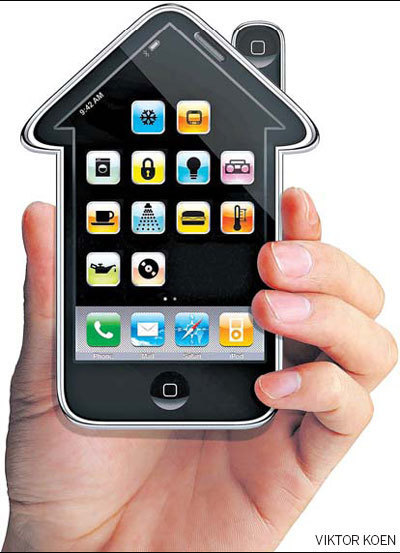Wi-Fi helps homes think about chores

Smart homes, networked homes and home automation are the cold fusion of domestic technology: always promised, never delivered.
They have remained the stuff of fantasy for most people because traditional home automation relies on meters of wiring and insanely expensive installation costs.
But little by little, home automation has crept into our houses and apartments thanks to two things many homeowners already have - Wi-Fi networks and smartphones.
A home's Wi-Fi network is the perfect low-cost, low-impact infrastructure for machines and devices to communicate with each other. And with a smartphone, you have the perfect wireless control panel that can work in your house or when you're halfway around the world.
One of the best examples of this new approach is Nest Labs. This Silicon Valley start-up has introduced a $250 device that not only uses motion detection to figure out when you're in a room and predict when you'll be out, but also gets on your home's wireless network so you can use your smartphone as a remote control.
This is helpful when you don't want to get up from the couch to turn the air-conditioning down, but even more so when you're leaving work and want to adjust the temperature before you get home so things are appropriately cool or warm when you arrive.
The air-conditioner manufacturer Friedrich has a line of window air-conditioning units called Kuhl that, later this year, will offer Wi-Fi capabilities. With a smartphone app, you'll be able to control the units from wherever your phone has a data signal.
Belkin is offering a line of Wi-Fi-enabled power accessories. You plug a WeMo unit into a wall outlet and then plug an electrical device (lamp, TV, stereo) into it. WeMo units are Wi-Fi enabled, and a smartphone app allows you to control when power is delivered to the device that's plugged in it. In addition to manually turning on and off lamps and such, you can put WeMos on a schedule, just like the older timer units.
A $50 WeMo unit works with the smartphone app; a $100 version adds a motion detector so your television can turn off, for example, if everyone leaves the room.
Wireless data is making itself useful outside the home as well. In olden times, lawn sprinkler systems were run on a schedule. The first big evolution was adding rain sensors, which could delay a scheduled watering if enough rain had just fallen. But that system remains only reactive, not predictive.
Sprinkler controllers from HydroPoint, sold under the WeatherTrak brand (the WeatherTrak ET Plus starts at around $300), pull in local weather data from the National Oceanic and Atmospheric Administration to adjust watering schedules. So if a thunderstorm is headed your way, the system can automatically reschedule the sprinklers to prevent wasting water. A smartphone app allows manual override of the system.
Not all Wi-Fi-enabled machines make sense. Earlier this year, Samsung showed off its WF457 ($1,700) and DV457 ($1,700) washer and dryer, which can be controlled and monitored via a mobile app. Samsung is keen to point out that this connectivity means the machines can send "your smartphone notifications when laundry is finished - no more running back to check or forgetting to unload the dryer."
The company earnestly informs us that "the app gives you remote control access of your machine; monitor your laundry's progress from your upstairs bedroom, while you're cooking dinner or even while you're out running errands."
This seems silly. After all, it's one thing to be able to set a thermostat or turn on some lights before you get home, but washing and drying clothes requires you to be there (the clothes can't move from one machine to the other). Is a push alert useful here? My machine already beeps loudly, if I want it to. As for monitoring my laundry's progress, I hope my life is richer and more engaging than that.
These products fall into the same category as the oft-ridiculed Internet-enabled refrigerator, as far as I'm concerned. You scan the bar codes on food as it is finished and the fridge compiles a shopping list for you. What's the point? (Where do I start? It won't account for food that has no bar code or food that isn't stored in the refrigerator.) An app on a smartphone could do that task more easily.
Many appliance manufacturers are looking into making maintenance and repair a cheaper, more efficient process, and Wi-Fi can help with that.
Imagine you have a refrigerator with an onboard diagnostic computer. The computer, with its sensors and algorithms, can tell that a fan belt is about to fail because of a variation in the fan speed.
Armed with that data and a wireless connection to the Internet, your refrigerator sends a message to the manufacturer to mail a new belt to your home address and call you to schedule a service call. The repair professional will then arrive knowing what has to be done, with the new part already in hand. That avoids the traditional first trip to determine the problem, and, we can hope, means the repair is made before the part fails.
For years, tech companies large and small have kept thousands of carpenters and tradespeople employed by building smart home demonstration rooms and houses.
The problem with that approach is that it usually assumed a single system to tie all your machines together.
The reality is that we are already well on the road to the smart home, but it's not one solution - just many small ones all taking advantage of what we already have.
The New York Times


















